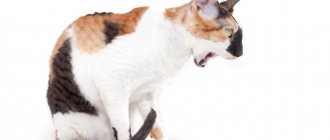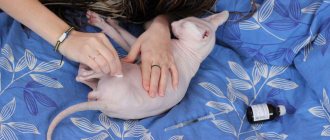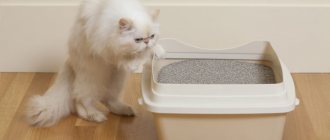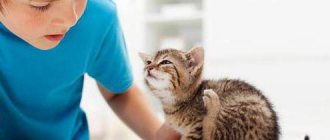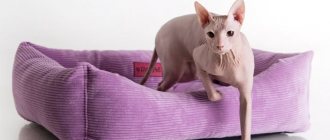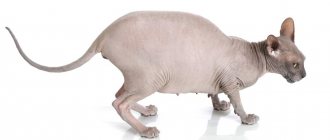Why do cats drink from the tap?
There are several versions that explain the habit of purrs drinking not from their dishes, but from plumbing equipment.
- Instincts and genetic memory. Wild cats are predators. The animals do this in order not to pollute the life-giving source with the decomposition products of the killed victims of their hunt. At home, owners most often place their bowls next to food. It is because of genetic memory that furry pets try to drink liquids away from the location of food.
- Some biologists and livestock breeders believe that the reason for the desire is the lower content of pathogenic microscopic organisms in running water. This version concerns animals that are released on the street, where they try not to quench their thirst from puddles, streams and ponds.
- Another version lies in the peculiarities of psychology, as well as in the habits of domesticated predators. Some cats perceive water jets as an imitation of the movement of small rodents. They approach the plumbing not so much to get drunk, but to play with the stream. In this way, the animals train their hunting skills.
- Most breeders of mustachioed meowing friends are inclined to believe that tap water is simply cleaner and tastier than stagnant drinking liquid. In the house, dust and grease residues from food constantly fall onto the water surface, which will lead to its contamination.
- Finally, another version is simple curiosity. Purrs are extremely curious animals, and they can drink both tap liquid and liquid from their own bowl.
Taking a bath
There are plenty of reasons why a cat drinks from a faucet, but does it harm the cat's body?
How to help an animal
If your pet drinks a lot of water, but is still playful, looks healthy and behaves adequately, you should pay attention to the cat’s diet. Perhaps most of the menu contains dry food that provokes thirst.
The transition to a new diet should be smooth so as not to stress your pet.
When water absorption has become excessively constant and is accompanied by other negative signs, it is necessary to look for the cause of polydipsia.
Not all problems can be diagnosed at home, so a trip to the veterinarian is the first step an owner should take.
Examination by a specialist
To understand why a cat is thirsty, a visual inspection is not enough.
The doctor prescribes a set of diagnostic examinations, which includes:
- Blood tests:
- general allows you to determine the composition of the lymphatic fluid at the cellular level and assess the possibility of inflammation;
biochemical helps check the functioning of the liver and kidneys, water-electrolyte composition and calcium content.- A urine test determines the presence of protein, glucose, and the presence of foci of inflammation.
- Glucosemetry helps diagnose diabetes mellitus.
In some situations, instrumental examination may be necessary - computed tomography, ultrasound of the abdominal cavity. They allow you to study the structure of internal organs, density, size, and general condition.
Having received the results of all research options, the veterinarian assesses the animal’s condition and makes an accurate diagnosis. Having determined the real cause of polydipsia, the doctor prescribes appropriate therapy.
How to normalize a cat's drinking regime
When choosing food for a pet, preference is given to wet food, which provides the cat’s body with the required amount of liquid. At the same time, we must not forget about the drinking regime.
The norm is determined individually, taking into account not only body weight, but also the composition of food, ambient temperature and physiological characteristics.
It should be taken into account that it does not happen from day to day.
Today your pet will drink a little more water than normal, tomorrow - less. You should not focus on isolated cases. If something confuses your cat’s behavior, it is recommended to keep an observation diary and record in it the amount of liquid drunk per day (not forgetting to indicate other indicators).
The results obtained over the week are processed, the average daily indicator is displayed, and only then the situation is assessed.
Expert opinion
Burmistrova Alena Valerievna
Breeder, 7 years experience.
If the pet has not drunk even half of its allotted amount during these days, then dehydration may develop. With an excess of 1.5-2 times, we can talk about polydipsia .
Any of the options is a reason not only to normalize the regime. This is the reason for the examination.
Is it harmful to give a cat water from the tap?
Tap water has an extremely harmful composition, especially in large cities. In addition, doctors do not even recommend washing your face, brushing your teeth, or taking a bath with it, since over the years bleach and other components harmful to human and cat health have been added to it.
Bleach in any quantity harms the gastrointestinal tract and genitourinary system of felines.
In addition, raw drinking liquids often contain pathogens and other pathogens of dangerous infections. A cat can constantly drink tap water and feel completely healthy. However, negative processes in the body gradually develop and diseases can manifest themselves in any form from mild to severe.
Water games
The cat constantly drinks from the tap - what are the reasons and what to do?
Many cat owners notice from time to time that their cat drinks running water from the tap. Some owners are even seriously concerned: the cat no longer drinks from the bowl, and requires only running water!
Everyone knows that a lack of fluid in any living organism leads to extremely negative consequences , and cats are no exception. Problems begin when the cat completely stops drinking from his bowl under any circumstances, remaining without a source of water while the owners are at work or sleeping... Why do cats love to drink running water from the tap so much? There are several theories about this.
It is believed that this is the influence of the evolutionary process and echoes of the “wild” life of cats. Being wild animals, cats needed to find their own sources of liquid - and as a rule, these were streams and small streams. It is likely that animals that consumed running water rather than stagnant water elsewhere had better health and could live longer lives. Falling, splashing water makes a characteristic sound by which it could be found - similar to the sound of falling water from a tap. Perhaps this is why our pets are so attracted to running water.
They also believe that such water is colder and tastes better than the same water poured into a bowl and left for some time - which, in principle, is not at all surprising.
And if your cat does not have such a habit, you could often see how, before drinking from a bowl, he pushes it with his paw, periodically spilling the contents on the floor - which also causes some trouble for the owners. And here some inquisitive minds say that in this way the cat helps itself to more accurately determine the level of water poured into the bowl - after all, many cats do not particularly like contact with water and will be happy to wet their faces as little as possible.
How much fluid your cat needs is also affected by its nutrition: cats that eat canned food require less water than cats that eat dry food, because canned food contains water, and also contributes to a slight, but still saturation of the animal with water .
For owners facing this problem, we have some advice:
— You can try throwing a couple of ice cubes into a bowl of water so that the water stays cooler longer and, therefore, has a fresher taste. This advice becomes especially relevant in the summer.
- Try to separate the eating and drinking areas - your pet may well be confused by the smell of food that he smells next to his water bowl.
— You can also try replacing the water dish with a bowl made of another material - your cat may not like a particular smell emanating from the bowl, such as the smell of plastic, which also retains more bacteria than stainless steel bowls and others.
— Automatic drinking bowl is another possible solution . Made in the form of a fountain, this automatic waterer also attracts your pet, reminding him of the need to drink. The water in such a drinking bowl never stagnates, continuously circulates and is enriched with oxygen, useful for any living organism. In addition, most models offered in pet supply stores are equipped with special filters that continuously purify the water, making it completely safe for your pet!
Remember that it is very important to ensure that your pet drinks enough water. This will help avoid many diseases associated with the urinary tract and kidneys. And if your cat suddenly begins to drink much less water, or much more, this may be a reason to visit the veterinarian, because a change in your pet’s drinking behavior may also be associated with changes occurring in the animal’s body.
Health to your pets!
What kind of water should I give my cat?
Ideally, mustachioed people should buy bottled water. It is unacceptable to give them carbonated liquid from a bottle. Buy several quality filters for your plumbing fixtures. Since these pets love to drink from their owners' mugs, owners are also not recommended to drink tap water.
In addition, breeders should ensure that cats receive sufficient moisture, especially if they regularly consume dry food.
According to the standards, 40 milliliters should be given per 1 kilogram of fluffy’s weight.
With an insufficient amount of fluid, the risk of urolithiasis increases, which is considered life-threatening for pets. If they refuse to drink from a bowl, tap, or other sources, contact your veterinarian.
Water bowl for cats
How much water should a cat drink per day?
Cats do not need a lot of liquid, but your pet's daily diet must include clean water. Broths and other liquid formulations cannot fully replace regular drinking water. The average daily water intake for a cat is 40-50 ml of liquid per 1 kg of weight.
If a cat eats wet food and eats other nutritious foods well, a certain portion of its daily fluid intake will enter its body. She gets the rest with drinking water. This is why the owner often thinks that the cat does not drink water at all or drinks very little.
How to stop a cat from drinking from the tap?
To wean a cat, you should use several quite effective methods:
- it is advisable not to place both bowls next to each other: one should be located at a distance from the other in order to exclude the manifestation of the pet’s animal instincts, its genetic memory of hunting in the wild;
- you can install several bowls of drinking water in different rooms so that the cat does not forget about the need to quench its thirst;
- it is optimal to purchase a transparent container for drinking so that the animal can see that there is drinking liquid there (ceramic containers are a good option);
- in hot weather, put a couple of pieces of ice in a bowl to keep the water cool;
- automatic waterer if you have several four-legged purring friends in your house;
- an alternative could be a small water fountain.
In any case, moisture for representatives of the cat family must be clean and free of bacteria and other harmful microorganisms. Otherwise, their health will be seriously compromised. If your cat drinks from the tap, try to wean him off using the above methods.
Cold means delicious
The thing is that cats, like any other living creatures, love everything fresh. But why is your pet not satisfied with water poured into a bowl?
Surely you have noticed that cold liquid has a fresher and more pleasant taste, which not all cats realize, but if it comes to them, then it is no longer possible to wean them off cool drinks.
Have you ever watched an animal begin to push a bowl of water so that its contents splash? He doesn't do this out of spite. The fact is that when it hits the floor, the water becomes cooler - it tastes much nicer.
Do not leave your laptop in direct sunlight - use a box
Serious problem: Mercedes is being sued for breaking panoramic windows
How to make your own baby towels with a hood: it turns out very cute
I solved the problem with ice
To help my cat finally get away from the kitchen faucet, I decided to use ice. I put it in a bowl of water intended for the pet to drink. Believe it or not, it worked. Fluffy very quickly left the tap and began drinking from his bowl again. There is nothing surprising in this, because now its cool contents seem fresher to him.
Don't forget that staying hydrated is vital to your pet's health. Be sure to pay attention to how much he drinks, because a change in the amount of liquid consumed may indicate the emergence of health problems and act as a signal that it is time to show your pet to the veterinarian as soon as possible.
Found a violation? Report content
